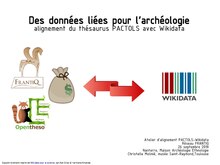GLAM/Newsletter/September 2018/Contents/France report
|
European Heritage Days; Linked data for archaeology; Paris: Edit-a-thon at Mobilier National
European Heritage Days
Rennes
On the 15 and 16 September, wikimedians hold a stand and a workshop at the Champs Libres (Museum of Brittany and library of Rennes) for the European Heritage Days. Like last year, we shared the space with OpenStreetMap. Amongst other things, we mapped the museum on OpenStreetMap and created the corresponding items about the rooms in Wikidata.
Commons
267 files were uploaded on Commons for the European Heritage Days 2018 in France.
Linked data for archaeology

On Wednesday, September 26, the Federation and Resources on Antiquity (FRANTIQ), a french network of libraries specialized in archaeology, organized at the Maison Archéologie & Ethnologie its second workshop dedicated to the alignment of the PACTOLS thesaurus with Wikidata. Created in 1985, the PACTOLS now contains nearly 30,000 terms covering the fields of archaeology and classical antiquity, initially intended to describe bibliographic resources in its union catalogue. Due to its specificity, uniqueness and flexibility of use, there are increasingly wider uses of the thesaurus in the context of editing or managing artifact inventories. Published autonomously, under free license, via the OpenTheso free software each term has an ARK identifier and the whole is downloadable in formats that comply with web data standards.
Continuing its logic of openness, in early 2017, FRANTIQ took the decision to align the PACTOLS with Wikidata via the Mix N'Match tool. For this purpose, the federation requested the technical support of Wikimedia France and Sylvain Boissel participated in the import and request of the data and contributed to the animation of the workshops. In a second step, reciprocal links will be established between the two vocabularies and translations and alignments with other repositories will be imported into OpenTheso. Today, with 25% of the thesaurus aligned, FRANTIQ is measuring all the challenges of its inking into the linked open data and wishes to intensify and accelerate the process in order to make the project a success.
The objective is twofold: to strengthen the role of the PACTOLS thesaurus as an essential resource in its field and to enrich the data on archaeology that deserve to be better represented on Wikimedia platforms.
Paris: Edit-a-thon at Mobilier National
On Friday, Septembre 21, a team of Wikimedians went to the Parisian center of the Mobilier National in order to help report and document high-end methods of handicraft. This day was orchestrated by Laurie and Ned, a team of EIG (Entrepreneurs for Public interest, kind-of "entrepreneur in residence" in various French administrations), as a mean to publicize a traditionally very secretive institution.
The Mobilier National
It is a part of the French Ministry of Culture, dedicated mainly to two missions:
- to store and maintain in good condition pieces of precious furniture available for the presidential residences, the ministerial offices or the embassies and consulates;
- to manage the three historic tapestry factories: the Gobelins Manufactory and the Beauvais Manufactory, producing traditional tapestries, and the Savonnerie Manufactory, specialized in knotted-pile carpets.
Visit
In the morning, we had the opportunity to catch a glimpse at the various workshops located in the 13th arrondissement of Paris. By teams of two or three, we went to meet the craftspeople in their rooms:
- the three manufactories have each a dedicated place or story in the buildings,
- there is a common "color chart" for the weavers, which is in itself a small department,
- and a dyeing team producing the desired colors for each new tapestry,
- the restoration operations are splitted between multiple workshops: one for the furniture (chairs and seats), another one for the chandeliers, clocks, locks and metallic pieces, one for the tapestries and a last one for carpets.
The weavers and more generally craftspersons welcomed us and showed us their workspaces, answering our questions and letting us film or photograph their tools and unique methods of production. It was an instructive, precious and globally appreciated time to exchange about their rare skills.
Edit-a-thon
In the afternoon, we settled in the nearby office of the EIGs with the dozen participants of the morning tour. Following a quick presentation and introduction to the Wikimedia projects, they uploaded to Commons their photographs and films, and began to use them to illustrate various concepts on Wikipedia.
-
Weaving process
-
Metal work
-
Selection of pigments
-
Color samples
Outcome
At the end of the day, we had contributed to:
- help 12 new contributors onboard the Wikimedia projects,
- upload 316 files to the dedicated category,
- use 59 of these files on Wikipedia (or Wiktionary) articles,
- create two new articles on Wikipedia in French.






